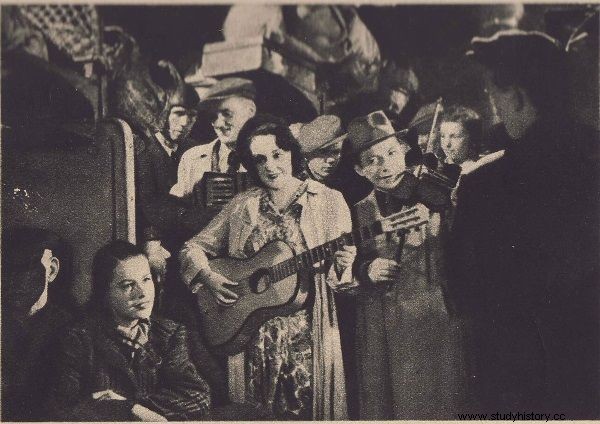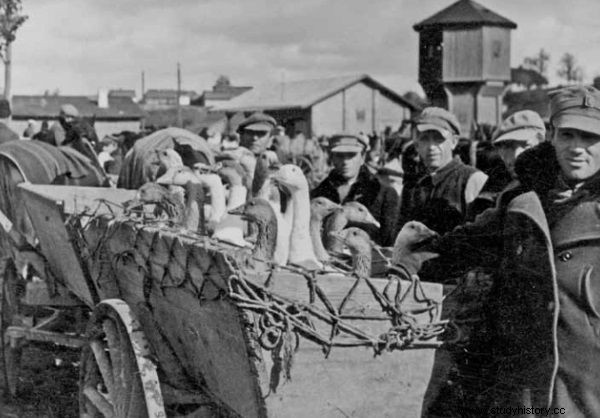There were no strong points for the Polish smuggler. Our grandparents smuggled in creatively, boldly and with a hint of madness. They always had a new way at hand and they knew perfectly well what to do to lead the Germans out of the way. Find out what their patent for success was.
- Is it true you smuggle everything? - Adolf Hitler asked the Polish smuggler.
- Of course! The man replied without the slightest hesitation.
- And could you please smuggle some of my soldiers into England?
- Of course, but it's an expensive business!
- It's okay, I pay any price Hitler declared
- Come on, okay, but there's one more problem!
- What? - asks Hitler
- We are specialists in chopping and only in this form can we smuggle your soldiers.
The above joke circulated in Poland during the German occupation. As is usual with pranks, there was a grain of truth in it. Perhaps Hitler did not come into dealings with Polish smugglers personally, but many of his subordinates did so. Poles, on the other hand, gave a real show of creativity during the war.

Still from the movie "Forbidden Songs", which perfectly illustrates the atmosphere of the then tight trains, full of smugglers.
Our grandparents were able to smuggle anything in. Although smuggling was punishable by imprisonment and even deportation to a concentration camp, this only motivated him to be more cunning. For example, Nazi propaganda could come to the rescue.
6. On the corpse
German soldiers, who had daily contact with Poles and Jews, were terrified of typhus. Posters that scare people with diseases, designed to discourage contacts with "subhumans", turned out to be too effective. In many cases, the occupiers preferred not to approach living Poles at all. What about the dead!
Instead of being outraged, the smugglers very quickly began to take advantage of this fact. They hid food contraband in coffins, for example. Transporting the body for burial in the deceased's homeland was not forbidden. It was enough to get a coffin and appropriate documents from somewhere, and instead of the deceased in an ash-tree, there was ... a supply of cold cuts, meat, bacon and other equally valuable victuals.
The soldiers controlling the funeral home cars did not look under the lid of the coffin - they could not be sure what made the rest of the coffin troubled and whether it was contagious. They preferred not to take any chances.

There is nothing like the grandma method! Photo from October 1939.
5. For grandma
Monika Żeromska, the daughter of the famous Stefan, witnessed the daring action of smugglers on the train going to Warsaw. Also in this case, clever Poles took advantage of the Germans' fear of disease.
In one of the seats, among the passengers, there was a crouching and motionless old woman. She was wrapped in scarves, aprons, a skirt that completely distorted her figure. A German bahnschutz approached granny, intending to scrupulously search for her. Then the woman's companions stepped in.
They began to explain that they were taking a seriously ill patient to the doctor and that they did not know what was wrong with her. Grandma is so weak she doesn't even have the strength to move!
Upon learning of the mysterious ailment of Germany, he immediately turned pale, stepped back and ... resigned from control.
At the station, the old woman was taken to a rickshaw and hastily taken from the platform. There would be nothing strange in all this if not for one detail. The ailing woman was in fact a slaughtered hog who was disguised as a human for the sake of ignorance. This action, which required a lot of courage and cold blood, definitely paid off for the smugglers.

Polish traders ... everything.
4. With the help of a railwayman
Most of the thriving smuggling routes ran along the railroads, and the trains were the means of transport to move bulk amounts of food. In this way, naturally in agreement with the railwaymen, one person could carry up to 200 kilograms of goods, and one train could fit up to 20 tons!
Simeon Surgiewicz, who worked on the railway, recalled that countless lockers were created in the carriages. The smugglers had blind walls and hiding places under their feet at their disposal. Above all, however, passengers bringing food to cities could count on the support of train drivers, managers and conductors. For example, there was a very effective warning system.
As soon as the information about the control reached the train crew, the driver gave the agreed signal on his whistle. The warehouse slowed down at a safe distance from the station, and smugglers were jumping out the door, taking their priceless merchandise.
3. Wearing
In occupied Poland, there were real sharks of secret trade. However, the most common were grays, carrying symbolic amounts of goods. They transported food for themselves and their family, taking as much as they could carry.
The vast majority of passengers-smugglers were dressed in rags, not wanting to risk their good clothes, after all, the most popular method of transport was the "wrapper" method.
The smuggler wore a long coat and hid all his wealth underneath it. The secret pockets contained groats, flour and other loose treasures, and a ham was tied around the waist , sausage or lard.

Food smuggled into the city immediately landed at the nearest market place.
There were also people who, for reasons of non-recognition, deliberately dressed properly. They hoped that this way they would avoid suspicion. They then carried their portion of contraband in a leather briefcase, a package tied with a string, or in a case for an instrument.
Such a smuggler could have been betrayed by the dogs used by the occupant on the railroad. Sometimes the most ordinary flies also brought doom. These small and extremely stubborn insects perfectly sensed even the smallest piece of meat and flew towards it. When an elegant gentleman was on the train and a flock of flies was circling around his luggage, the fellow passengers knew in no time what he was carrying.
The methods of small smugglers in a playful, but still one hundred percent accurate way are reflected in one of the "forbidden songs":
It's dark outside,
The train is crowded,
So the idyll begins,
He hugged her halfway,
She was fat like an ox,
Because a diamond is hidden under the coat.
Now it's war
Whoever trades lives.
When I sell a diamond,
Lard, black pudding,
This moonshine is made too I'll drink.
Under the heart drip, drip,
Rhombus and pork loin,
And the train runs like crazy
Schaboszczak and sneezes
This is a good snack ,
And two brawns under the bench.
2. On foot and by bike
The well-known feminist activist and writer, Zofia Nałkowska, was well over fifty in 1939. However, fate forced her to put aside the life of the sedate lady. I had to feed my sister and my ailing mother. Under the occupation conditions, the writer could get the food needed for the whole family in only one way:by smuggling. Ordinary smugglers used bicycles to transport food and, under the cover of night, pedaled even several dozen kilometers. The writer followed suit.
In her "Diaries of the Time of War" she described hiking and biking trips to Tłuszcz, some 40 kilometers from Warsaw. She brought potatoes from there, one of the staples of the occupation menu. She transported them in various ways, sometimes strapped to the bicycle, other times in a bag hanging on either side of her neck.
1. Grinder method
Nałkowska could not make a fortune, because she did not have anything really profitable to exchange. One ordinary girl from Sędziszów Małopolski, Maria Kwiatkowska, turned out to be much more inventive than the famous feminist. She had a key advantage:she knew what was bothering the villagers.

Nałkowska (second from the left in the bottom row) at the inaugural session of the Polish Academy of Literature in 1933 with the participation of the President of the Republic of Poland, Ignacy Mościcki. Nobody could have expected that in a few years a war would break out and the writer would have to smuggle potatoes on her backs.
After the conquest of Poland, the Germans seized the entire key economic infrastructure, including the mills. At the same time, they ordered all burials to be destroyed or handed over to them. An ordinary peasant could no longer grind his grain legally at home. In turn, when going to the mill, he had to reckon with the fact that he would lose a significant part of the flour.
Maria found a way. In the city, she bought coffee grinders in the hardware store. The instruction manual did not provide for this, but they could also be used to grind whole sacks of flour. Now the peasants could not only provide bread for the family, but even start selling it. Meanwhile, Maria Kwiatkowska could ask for any price in exchange for her grinders ...
***
"Okupacja od Kuchni" is a moving story about the times when illegal pig slaughtering could lead to Auschwitz, vegetables were grown in the courtyards of tenement houses, and used coffee grounds were traded on the black market. It is also an amazing cookbook:full of original recipes and practical tips from 1939-1945. We recommend!
